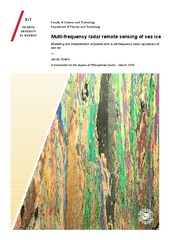| dc.contributor.advisor | Brekke, Camilla | |
| dc.contributor.author | Grahn, Jakob | |
| dc.date.accessioned | 2018-08-09T08:23:25Z | |
| dc.date.available | 2018-08-09T08:23:25Z | |
| dc.date.issued | 2018-06-08 | |
| dc.description.abstract | This thesis deals with polarimetric multi-frequency radar signatures of sea ice. It presents a thorough background on the topic and three case studies.
The first study presents a global sensitivity analysis of the fully polarimetric radar backscatter response from snow covered sea ice. The analysis is global in the sense that it takes into account the observed ranges of sea ice properties that are needed as input, and it attributes a quantitative sensitivity measure to each individual input parameter, such that the most influential one(s) can be identified. Generally it can be concluded that parameters describing roughness of interfaces and dimensions of brine inclusions and snow grains, are more important than parameters describing bulk properties such as salinity, temperature and density.
The second study complements the sensitivity analysis by showing that the considered backscatter model compare well to SAR data at both C- and L-band, for ice identified as lead ice and ice floes (which presumably is first year ice). Generally, C-band data compare better than L-band data. Likewise, the ice identified as ice floes is better represented than ice types identified as lead ice. The model primarily deviates from the data in the co-polarised phase difference and the cross-polarised channel.
The third study focuses on the backscatter from frazil and grease ice. A model for the dispersion relation of gravity waves in viscous ice slicks is considered and linked to a band ratio. This ratio provides the backscatter relative to a reference radar frequency and can readily be compared to data. The analysis concludes that under certain conditions, ice slicks have strong impact on the spectral behaviour of the radar backscatter. According to the numerical simulation, the damping due to ice slicks is strong at wavelengths relevant to radar remote sensing. | en_US |
| dc.description.doctoraltype | ph.d. | en_US |
| dc.description.popularabstract | What does quantum theory, satellites and microwaves have to do with polar bears and narwhals? The Arctic sea ice cover is changing and thus is the habitat of a major part of the Arctic fauna. To better understand how to measure these changes, advanced physical models that describe how radar waves interact with sea ice can help us. In this thesis, models, some of which originate from quantum field theory, are used to explain what information can be extracted about sea ice by means of radar remote sensing.
Sea ice is a fundamental part of the polar ecosystems, but it also plays an intricate role in the climate system. Sea ice conditions need to be considered in local and regional weather forecasts and sea ice is of increasing interest to the industries involved in for example oil and gas exploration, shipping, fishing and tourism.
Detailed information about sea ice is however needed over very large areas. For this, air- and spaceborne radars are useful tools. Radars have the advantage of transmitting their own source of illumination in the form of microwaves that can penetrate through clouds. They can therefore operate in darkness as well as in bad weather conditions, which is particularly important in the polar regions which are frequently affected by clouds and are dark during the polar night.
A key design parameter of a radar is the radar frequency. The full potential of using data acquired at multiple frequencies have however still not been properly clarified. The diversity in frequencies used in recent and future satellite missions raises the interest in the multi-frequency aspects of radar remote sensing of sea ice. There are still many unresolved or only partly resolved issues, in particular in the basic understanding of how the microwaves at different frequencies interact with the ice. This thesis provides multi-frequency modelling results, a unique sensitivity study and new insights on the spectral behaviour of radar signals from ice in the process of being formed. | en_US |
| dc.description.sponsorship | UiT, Centre for integrated remote sensing and forecasting for arctic operations (CIRFA) (NFR project number 237906) | en_US |
| dc.identifier.isbn | 978-82-8236-302-0 (trykt) og 978-82-8236-303-7 (pdf) | |
| dc.identifier.uri | https://hdl.handle.net/10037/13373 | |
| dc.language.iso | eng | en_US |
| dc.publisher | UiT Norges arktiske universitet | en_US |
| dc.publisher | UiT The Arctic University of Norway | en_US |
| dc.rights.accessRights | openAccess | en_US |
| dc.rights.holder | Copyright 2018 The Author(s) | |
| dc.rights.uri | https://creativecommons.org/licenses/by-nc-sa/3.0 | en_US |
| dc.rights | Attribution-NonCommercial-ShareAlike 3.0 Unported (CC BY-NC-SA 3.0) | en_US |
| dc.subject | VDP::Mathematics and natural science: 400::Physics: 430::Electromagnetism, acoustics, optics: 434 | en_US |
| dc.subject | VDP::Matematikk og Naturvitenskap: 400::Fysikk: 430::Elektromagnetisme, akustikk, optikk: 434 | en_US |
| dc.subject | VDP::Mathematics and natural science: 400::Information and communication science: 420::Simulation, visualization, signal processing, image processing: 429 | en_US |
| dc.subject | VDP::Matematikk og Naturvitenskap: 400::Informasjons- og kommunikasjonsvitenskap: 420::Simulering, visualisering, signalbehandling, bildeanalyse: 429 | en_US |
| dc.title | Multi-frequency radar remote sensing of sea ice. Modelling and interpretation of polarimetric multi-frequency radar signatures of sea ice | en_US |
| dc.type | Doctoral thesis | en_US |
| dc.type | Doktorgradsavhandling | en_US |


 English
English norsk
norsk
